Abstract
Volleyball sport game is promoted and practiced by a growing number of high-school students in physical education lessons, it consisting itself into an excellent means for improving and maintaining physical condition, also contributing to the objectives of school Physical education. Treating physical education lesson organized by high school students from the perspective of using the volleyball, can increase mobility of overall body and especially of motor skills required for it to be played, and the backdrop of these qualities can be achieved faster and with correct appropriation to the required technical elements for practicing this game. For a more efficient contribution to the objectives of school age, specific means volleyball can be organized and carried out in various forms. Their use in the lesson is useful, but only when they contain actions that lead directly to perform certain instructional goals of educative type, to improve driving ability of the students included in various studies. Volleyball is a team sport game, representing a significant branch of physical activity, with a significant educational value. It cumulates on the one hand the positive effects that sport and physical exercise, and on the other hand educational outcomes of this game. Analysis of Physical education and sport curricular area for the game of volleyball denotes accessibility to all ages, some physical and mental training being applicable from the early hours of physical education.
Keywords: Sportsvolleyballphysical educationstudents
Introduction
In physical education class is increasing the share of sports games in the idea of turning their multiple influences on the development of motor and sports performance at that age, to obtain information necessary for sustained sports activities and sports culture.
Analysis of curricular area physical education and sport for the game of volleyball denotes accessibility to all ages, with some physical and mental training applicable from early hours of physical education (M.E.C.Ș, 2001).
Volleyball sport game is promoted and practiced by a growing number of high school students in physical education lessons, it consisting into excellent means of improving and maintaining physical condition, contributing to the objectives of school physical education.
Treating physical education lesson organized for high school students from the perspective of using the volleyball game, can increase the motility of overall body and especially the motor skills required for this game, and amid these qualities can be achieved faster and accurate ownership technical elements required to practice fully game (Cârstea, 2000).
Problem Statement
Conforming to the literature, both national and internationl, it is known that for a more efficient contribution to the objectives of school age, specific means volleyball game can be organized and carried out in various forms. Their use in the lesson is useful, but only when they contain actions that lead directly to perform certain instructional goals - educative, to improve the driving ability of students (Pehoiu, 2005).
Volleyball is a team sport game, representing a significant branch of sporting activity, with a significant educational value. It cumulates on the one hand, the positive effects that sport and physical exercise, and on the other hand, the educational outcomes of the game.
The game of volleyball seeks development in equal measure, the driving qualities of the entire complex, with its rich content and variety motor movements involved (Păcuraru, 2002).
Motricity development is conditioned by internal factors (inherited characters and nonexistent in large work functions of the body) and external factors (living conditions, education, environmental, requests the body and its various activities).
Research Questions
Our study is due to find an answer for the main question of the research, namely: “How can we improve driving capacity development, with using rational and conscious issues specific to the game of volleyball in physical education lesson in the high school classes, especially regarding strength, quality of entire body, that can be improved in this group-age?”.
Purpose of the Study
This paper highlights the importance of using specific volleyball game means quality driving force for the development for high school students. It is most known that special education lessons and sports physical systems consist of drive means that sometimes, due to the complexity of the task they have to fulfill, are sometimes cumbersome and disincentives. It is necessary that this thing not to happen during these lessons with children, because of the risk of them removes these from the sport considerably grove.
We can highlight in our study that, by specific means of volleyball, being well chosen and selected, that there could be achieved good objectives regarding scholar Physical education and sport, generally, among other motion qualities desired to be developed at this ageing stage.
Research Methods
During present study we used following research methods: observation, studying of existing documentation, testing (long jump from standstill, expansion, pushups, lifting the trunk of lying dorsal service top zone 5, assisted by two hands from above), statistical and mathematical method and graphical format (Dragnea, 1984).
Current research was conducted between 15.01-15.05.2016, at “Constantin Carabella” High School of Târgovişte, on a total of 26 students of class X (14 boys and 12 girls), being included in a single class, this being made with the help of the specialized teacher of mentioned class, with the agreement of the management of the high school. Earlier research test (15.01.2016) was performed initial tests by which the quality was reflected in terms of driving force state of the subjects. The research was concluded with final testing, which highlighted a veritable progress from initial testing (15.05.2016).
In the research we sought not to compare results obtained by different methods of training, but focusing on highlighting the growth they bring specific means of volleyball game quality driving-force in the development of girls in high school, especially. During the study were carefully chosen means used in the game of volleyball and of physical attributes, which were distributed in lessons during the two semesters with the observance of methodological requirements: exercises to be measurable; to have a minimum effort and maximum efficiency; to be located on developing motor skills combined: mobility, strength - speed driving qualities required to play with gradually increasing intensity; to have a precise determination of the number of repetitions with rest intervals and duration to enable proper restoration of key-physiological indicators.
In selecting exercises structures there was considered developing important physical qualities necessary to practice volleyball: force lower limbs, detachment (vertical detention) and upper limbs (technical elements like attack hit, lifting, etc.). The exercises were divided manifestation of combination motor skills as its main forms (one of which having the highest importance in taking action).
Findings
Following the test applied to the students of Xth class, we have obtained some data that we have evaluated according to certain criteria, assessing the level at which subjects was situated along to investigation and to what extent exercises used were effective on their motility. Analyzing data obtained by calculating averages for both initial testing and final one, as it can be seen, proved an improvement in results in all samples applied to girls and boys, thus confirming the hypothesis of this study.
Long Jump on place (cm)
At this exercise, sample group of boys has a difference between the initial testing (205.57 cm) and final one of 212.85 cm, which is better with 7.28 cm and is slightly higher for girls than in the case of boys: an average of 165.16 cm to final testing of the average of 156.58 cm to the original, with a breakthrough of 8.58 cm, which shows the influence of volleyball means used in physical education classes (fig. 1).
The graphical representation shows an upward evolution of media from one to another test in both groups (boys - girls).
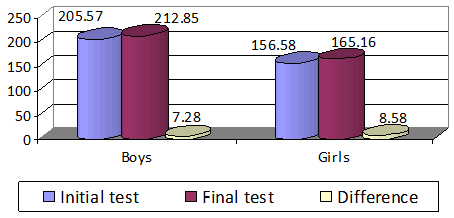
Vertical jump (cm)
By this exercise is measured vertical force detachment, it being essential in the game of volleyball, achieving necessary technical procedures such as stroke, blockage at the snood, lifting etc.; we can see that the results correspond to the level of development of motor skills at this age (fig. 2).
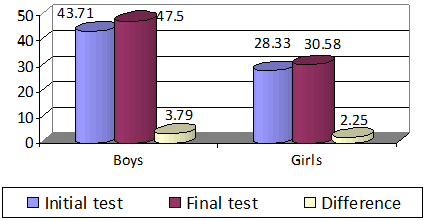
Referring to fig.
Push-ups (no. exercises / 30 seconds)
Analysis of the results were recorded media “float” statistical larger growths from one test to another (fig. 3).
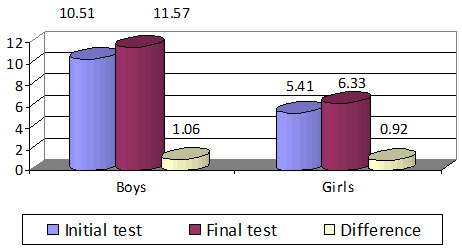
Thus, the boys, in final testing, progress was 1.06 sec for executions of 30 sec. Therefore slightly better results than those of girls achieved a mean improvement of 0.92 in 30 sec of executions.
Raising the lying dorsal trunk 30’’
To this sample group of boys, the difference between the initial testing (execution 22.14) and final testing (24.28 executions) is higher by 2.14 executions and for girls is lower than boys: an average of 21.16 exercises of final testing was compared to an average of 20.25 in the initial exercises, exercises with a breakthrough of 0.91 (fig. 4).
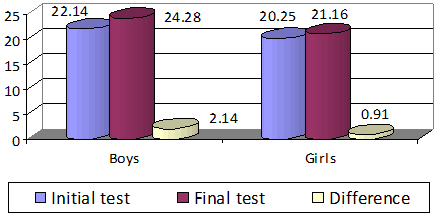
Service in zone 5 / no. of success in 10 attempts
For this specific element of volleyball game, there was shown progress for both groups, from initial testing to the final, with a sensitive growth rate similar between boys and girls, which shows the positive influence of the means used to develop quality driving force in physical education lessons (fig. 5).
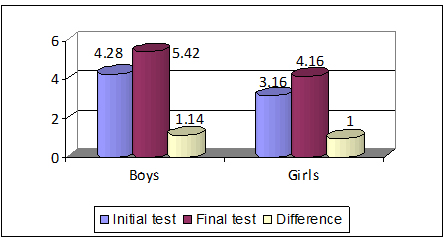
In this order, the boys got a successful improvement of 1.14 out of a total of 10 attempts and progressing-rate for girls less than that of boys, with a success for initial attempts. Those regardings indicate that technical means and structures of the game of volleyball - carefully selected and properly dosed - can improve both the technical execution of the service element, as well as motor skills in general means.
Passing with two hands from above (number of executions in 30 sec.)
This exercise is very much influenced by the transmission of technique fairway. Through its evaluation was monitored speed of execution in relation to the force arm.
Boys recorded, at the initial testing, an average of 13.92 executions and girls of 12.75 executions. Finally, boys show an average of 15.23 executions and girls 14.83 repetitions in 30 seconds (fig. 6).
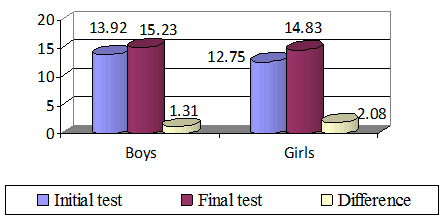
We can see, therefore, that at baseline the average results for boys are better than one of the girls. Conforming with the above chart, there were shown increases in both groups (boys and girls), with a greater progress in girls who get a difference of 2.08 executions, while boys get growth only 1.31 executions, which what makes us say that girls have a better quality of execution speed driving - a segmental force more visible.
Conclusion
To obtain traction indices raised of quality driving explosive force (expansion) at higher rates, it is preferable to perform adequate efforts using various means, leading to acquire the basics of the game of volleyball without tracing, an approach of technical performance issues, but also an active participation in some form of sport activity.
To enhance effectiveness of volleyball in Physical education classes, we recommend the following remarks:
Global practicing using mainly the very beginning of training with little emphasis on correctness movement;
Frequent use of structures for driven completion (passing over the fillet);
Use of rubber balls handball, basketball, football etc.;
Extending the game with a reduced squad, actual uneven, mixed on lower ground with improvised fillets.
In physical education classes it is appropriate to grant importance to learn fairway top, three shots organization, service, assembly game with a reduced squad on the small field. They must learn at least to the level of consolidation.
Other items such as jam, attack, taking down can be fixed to the initiation stage or to the bonding - consolidation.
Playing volleyball in physical education class may be present in almost all the lessons because it requires little space to practice, numerically smaller materials; also can be organized links from the second lesson, by touching a ball drawn on the wall after a running speed or running after-school items.
Also, there can be used workshops dividing class into two groups: a workshop making assists, and the other elements of gymnastics or athletics. Volleyball infrastructures may be present throughout the lesson by practicing non-stop, which can contribute to a high density loads. The conclusion of such lessons for mini volleyball competition increases efficiency active participation of students and lessons.
Learning the basics and the game with a reduced squad will improve faster if physical education class creates prerequisites for boosting self-employment.
Acknowledgments
All this material is the only result of author’s research.
References
- Cârstea, Gh. (2000). Teoria şi metodica educaţiei fizice şi sportului. Bucureşti: Editura AN-DA.
- Dragnea, A. (1984). Măsurarea şi evaluarea în educaţie fizică şi sport. București: Editura Sport-Turism.
- M.E.C.Ş. (2001). Ghid metodologic de aplicare a programei de educaţie fizică şi sport, învăţământ gimnazial. București: Aramis Print.
- Păcuraru, A. (2002). Volei – tehnică şi tactică. Galați: Editura Fundaţia Universitară.
- Pehoiu, C. (2005). Continuitatea activităţii de educaţie fizică în învăţământul preşcolar, primar şi gimnazial. Târgoviște: Cetatea de Scaun.
Copyright information

This work is licensed under a Creative Commons Attribution-NonCommercial-NoDerivatives 4.0 International License.
About this article
Publication Date
30 July 2017
Article Doi
eBook ISBN
978-1-80296-026-6
Publisher
Future Academy
Volume
27
Print ISBN (optional)
-
Edition Number
1st Edition
Pages
1-893
Subjects
Teacher training, teaching, teaching skills, teaching techniques,moral purpose of education, social purpose of education, counselling psychology
Cite this article as:
Savu, C. F. (2017). Development Of Force By Using Volley Means In High School Classes. In A. Sandu, T. Ciulei, & A. Frunza (Eds.), Multidimensional Education and Professional Development: Ethical Values, vol 27. European Proceedings of Social and Behavioural Sciences (pp. 707-713). Future Academy. https://doi.org/10.15405/epsbs.2017.07.03.84

